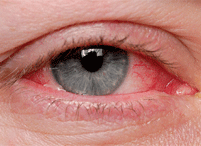Their findings, published in the April 15 issue of PLoS Pathogens, could lead to the development of an effective pharmaceutical treatment for pink eye.
Using a mouse
model, the researchers tested individual components of the active adenovirus to
elicit a unique immune response. Following a preliminary analysis, the researchers
confirmed that viral DNA, viral gene expression and/or viral replication did
not directly contribute to the development of inflammation secondary to pink
eye.

The inflammation from viral conjunctivitis was traced to the virus' protein coating.
Instead, “we found that it is the protein coating around the virus that is most inflammatory in the eye,” says senior author James Chodosh, M.D., M.P.H., cornea surgeon at the Massachusetts Eye and Ear Infirmary at Harvard Medical School.
The researchers concluded that inflammation secondary to pink eye could be blocked by a peptide that contains critical components of the adenoviral capsid.
“With this new understanding, we are a step closer to developing a treatment for this common––and highly contagious––eye condition,” Dr. Chodosh says.
Chintakuntlawar AV, Zhou X, Rajaiya J, Chodosh J. Viral capsid is a pathogen-associated molecular pattern in adenovirus keratitis. PLoS Pathog. 2010 Apr 15;6(4):e1000841.

